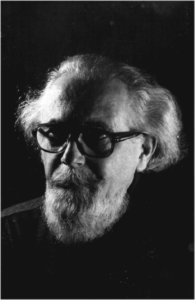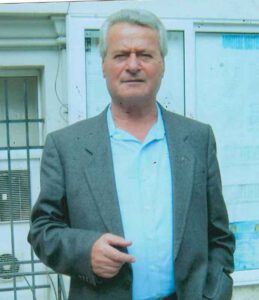Ervin Ditrói Israeli Daily Newspaper in Hungarian, 1990 There are...
Read MoreJean-Christophe Amman

Review of the Exhibition Advanced Retrospective
Review of the Exhibition Advanced Retrospective
In the summer, I read Isaac B.Singer’s Shadows on the Hudson. The novel is set in New York immediately after World War II.
The people there who fled from Nazi persecution are condemned to fail. But out of that failure, they manage to draw unusual and surprising strength. What is an ordered, straight-lined life compared to one that is characterised by breaks and constant reorientation?
Born in 1948, Arp Kovacs spent his youth in Transilvania, Romania.
He studied at the art schools in Neumarkt and Klausenburg, was teacher for eleven years, emigrated to Israel in 1985 and has lived in Frankfurt since 1994.
The work by Arp Kovacs is characterised by these breaks in his collective biography and the lives of those whom he consciously experiences and articulates as emotional contradiction in his paintings.
Arp Kovacs has no homeland and is at home everywhere and nowhere.
Condemned to fail. But what does it failure mean?
Alberto Giacometti repeatedly spoke of failure.
Friedrich Dürenmatt describes his failure with the words: „My imagination was too radical, I found nothing in language that suited it to form a longer narrative. I stood in emptiness, a writer without the ability to write, just as I would have felt as a painter without ability to paint.“
As Wilhelm Genazino recalls, it was Samuel Beckett who made the influential statement: „To be an artist is to fail, as no other dare to fail.“
Genazino continues: „The sentence thereby reaches the core of the problem because the artist often endures the nearness of failing existence throughout his life… In failure, the biographical itself becomes reflexive.“
Thus, failure has an inherent quality when it occurs out of the necessity of art and the obsessive power of the act of painting.
In other words: when the search for form achieves an added value that refuses to leave the artist alone and constantly drives him forward.
It is the search among constantly new interrelationships that creates Arp Kovacs self, that intertwines like recollections and gaps in one’s memory, that combines with moving abruptness like traces of thought.
Fulfilment is undermined by doubt. Doubts can become statements that are immediately questioned again. We are indeed unaccustomed to perceiving the work of Arp Kovacs because they encourage us to take new paths, through the trees and undergrowth, that may improve our orientation
Prof. Dr.Jean-Christophe Amman
Director, Museum of Modern Art,
Frankfurt/Main (1991-2002)
August 26, 2004
More Comments
Jean-Christophe Amman
Jean-Christophe Amman Review of the Exhibition Advanced Retrospective Review of...
Read More



